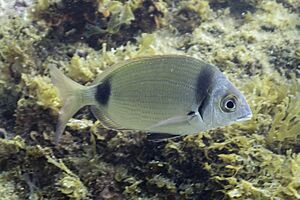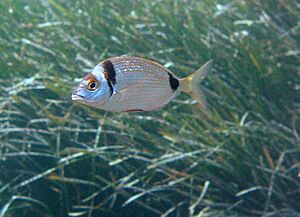Common two-banded sea bream facts for kids
Quick facts for kids Common two-banded sea bream |
|
|---|---|
 |
|
| Arrábida Natural Park, Portugal | |
| Conservation status | |
| Scientific classification | |
| Synonyms | |
|
The Diplodus vulgaris, also known as the common two-banded sea bream, is a type of ray-finned fish. It belongs to the Sparidae family, which includes many kinds of sea breams and porgies. This fish lives in the northeastern Atlantic Ocean and the Mediterranean Sea. It's a popular fish for people to catch and eat, and it's also raised in special fish farms.
Contents
About the Common Two-Banded Sea Bream
The common two-banded sea bream was first officially described in 1817. A French naturalist named Étienne Geoffroy Saint-Hilaire gave it the name Sparus vulgaris. He found it in the Mediterranean Sea near Egypt.
The scientific name vulgaris means "common." This probably refers to how often this fish was seen or caught in its natural habitat.
What Does It Look Like?
The common two-banded sea bream has an oval-shaped body that is quite deep and flattened from side to side. Its mouth is slightly pushed forward and has somewhat thick lips.
It has eight thin, brown, incisor-like teeth at the front of each jaw. Behind these, it has several rows of molar-like teeth along the sides of its jaws.
Its top fin, called the dorsal fin, has 11 or 12 strong spines and 13 to 16 soft rays. The fin on its underside, called the anal fin, has 3 spines and 12 to 15 soft rays.
The fish is usually grey, greenish, or brownish, and lighter on its belly. It has two dark bands on its body. One dark band is near its head, stretching towards its pectoral fins and the back of its gill cover. The second dark band goes around its tail end, just before its tail fin. Younger fish might not have this second band as clearly.
There is also a black spot at the base of its pectoral fin. Its tail fin is dark, getting darker towards the edges. The other fins are greyish and also get darker at their edges.
This fish can grow up to about 45 cm long, but it's more common to see them around 22 cm. The heaviest recorded common two-banded sea bream weighed about 1.3 kg.
Where Do They Live?
You can find the common two-banded sea bream in the northeastern Atlantic Ocean. This includes areas from the Canary Islands and Madeira up to the Bay of Biscay. They also live all over the Mediterranean and Black Sea. Recently, they have been spreading north in the Bay of Biscay, reaching places like the Channel Islands and Normandy.
This fish lives in both rocky and sandy areas, usually in water less than 50 meters deep. However, they can be found as deep as 160 meters. Young fish often live among seagrass beds, which provide good hiding places.
What Do They Eat and How Do They Live?
The common two-banded sea bream is a carnivore, meaning it eats other animals. Studies have shown that they eat crustaceans, molluscs, worms, fish eggs, and sea urchins. Smaller fish tend to eat tiny zooplankton, while larger fish prefer to eat creatures that live on the seafloor.
These fish are also special because they are protandric hermaphrodites. This means they are born as males and later in life can change into females!
In some areas, like the Gulf of Gabes in Tunisia, the spawning (breeding) season is from October to February. In the Aegean Sea, it's from September to March. During these times, females can lay a lot of eggs, sometimes over 300,000!
The common two-banded sea bream can be a host for many different kinds of parasites, over 50 species have been found living on them.
Fishing for Sea Breams
The common two-banded sea bream is caught for food in many parts of the Mediterranean. In some places, like Sicily and Egypt, it's part of larger fishing operations. In other areas, smaller, local fishing boats or people fishing for fun catch them.
You can often find this fish in markets across the Mediterranean. It's sold fresh, frozen, or even salted. People catch them using traps, nets, lines, and even spearing.
In Portugal, Diplodus sea breams are very important. They are among the top fish caught and sold, bringing in a lot of money for fishers. This fish is also a good candidate for aquaculture (fish farming) because it can live in different salt levels and doesn't need special hormones to reproduce.



